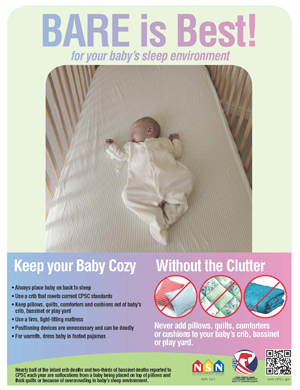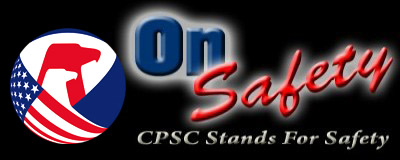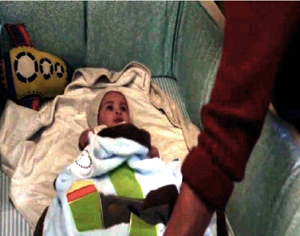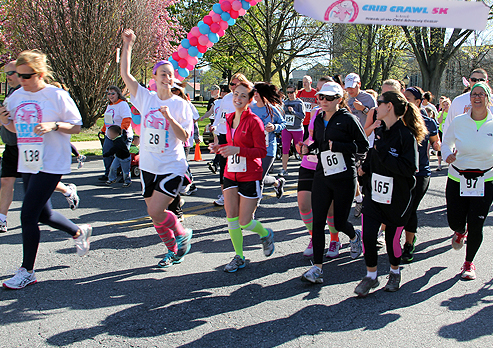
Post this free poster in your community or on your Facebook and Pinterest pages. Spread the word.
CPSC staff estimates that between 1992 and 2010 there were nearly 700 deaths involving infants 12 months and younger related to pillows and cushions placed in or near a baby’s sleep environment. Nearly half of the infant crib deaths and two-thirds of bassinet deaths reported to CPSC each year are suffocations caused by pillows, thick quilts and/or overcrowding in the baby’s sleeping space.
The safest place for a baby to sleep is in a safe crib. A safe crib is one that meets CPSC’s strong federal safety standards and is clear of clutter. That means no pillows, no heavy quilts, no thick blankets, no pillow-like stuffed toys or other large stuffed toys and no child carrying devices, recliners or sleep positioners.
Many parents are aware of the Back-to-Sleep Campaign to reduce the risk of SIDS. Putting your baby to sleep on his or her back also helps prevent suffocation. Be sure to always place your baby on his/her back on a tight-fitting, firm, flat mattress or any surface that comes with the bassinet and play yard. Crib mattresses need to fit tightly, too.
I use a pillow, why shouldn’t my baby?

This medical examiner re-creation shows a hazardous situation. Babies should not be placed to sleep on anything pillow-like or in a crib filled with items. Bare is Best.
Babies and adults are different. A pillow can block a baby’s nose and mouth and can cause a baby to suffocate. On average, there are 32 infant deaths a year on pillows used as mattresses or to prop babies’ heads. The majority of these deaths involve infants in their first three months of life.
Parents can safely start using pillows for children who are 1½ years old, about the same age at which parents can safely move children out of the crib and either into a toddler bed or onto a mattress on the floor.
No thick blankets? My baby will be cold.
If you’re worried about the temperature in your baby’s room, dress your baby in warm clothes. You can also put a thin blanket on your baby. Do not use thick blankets or quilts. Young babies can and do get their faces stuck in thick blankets and suffocate.
Should I use a ‘sleep positioning’ device?
No. CPSC and the U.S. Food and Drug Administration began warning parents in September 2010 to stop using sleep positioners. There is currently no scientific evidence supporting medical claims that have been made regarding these products. CPSC and FDA are aware of 13 reports of infants between the ages of 1 and 4 months who died when they suffocated in these positioners or when they became trapped between a sleep positioner and the side of a crib or bassinet. CPSC has also received dozens of reports of infants who were placed on their backs or sides in sleep positioners, only to be found later in potentially hazardous positions within or next to the sleep positioners.
A major concern is the use of these products to keep a baby on its side, which is an unstable position. Infants placed on their sides are more likely to flip onto their stomachs because their backs are pressed against the side of the sleep positioning product. Because these products are designed to keep a baby from changing positions, infants who end up on their stomachs are then unable to free themselves. Young infants can suffocate because they don’t have the neck strength to move their heads.
Is it safe to put a car seat, carrier, infant recliner or other item inside the crib with my infant in it?
No. This is not a safe practice. Many of these items can tip over when placed on top of an uneven surface such as a mattress. Babies have also flipped over the side of these products and become wedged between them and other items in the crib. Since 2003, CPSC is aware of at least 9 deaths of infants in car seats, carriers, infant recliners and bouncy seats that were placed on a soft surface such as a bed, crib, play pen, air mattress or sofa.
Can I put toys in the crib/play yard/bassinet?
An uncluttered sleeping space is the safest sleeping space for a baby. Again, Bare is Best.
Toys attached to the sides of a crib should be securely attached to a single side. Make sure the toy does not contain any cords or straps that could wrap around a child’s neck. Avoid hanging crib toys with protruding parts that a child can use to pull themselves up and out of the crib or from which small parts might detach.
Don’t fill your baby’s crib, play yard or bassinet with large toys or decorative or nursing pillows, thick blankets or comforters. This is particularly important for children who are 4 months and younger.
Is there anything I need to know about my baby monitor?
All baby monitors with cords and other corded items need to be placed at least 3 feet away from a crib. CPSC knows of seven deaths and three near-strangulations since 2002 involving video and audio baby monitor cords. The monitors and cords were placed within a child’s reach.
I use a bassinet. What should I look for in my bassinet to make sure it’s safe?
CPSC is working on a new bassinet safety rule. Before buying or borrowing a bassinet, check this bassinet recall list to make sure the product has not been recalled. Make sure to follow the bassinet’s setup instructions and be sure that all fasteners are secure, including all snaps and Velcro. Use only the mattress supplied by the manufacturer for your specific bassinet and make sure that you assemble the bassinet properly. Improper assembly can lead to baggy or collapsed sides, gaps and openings that are dangerous areas in which babies can get trapped.
Those play yard mattresses are so thin. Won’t my baby be uncomfortable on it?
Play yard mattresses are thin for a reason. The play yard is a flexible structure. Adding extra padding, foam or mattresses to the play yard can cause babies to suffocate in one of two ways:
- The baby can get his or her face stuck in the added mattress or other soft items or
- Because of the extra additions, the flexible sides of the play yard can be pressed out. This creates dangerous and deadly gaps between the side and the added material in which a baby can get trapped.
Use only the mattress that came with the play yard. Before buying or borrowing a play yard, check this playpen/play yard recall list to make sure that the product you are using has not been recalled.

A baby should be placed to sleep flat on the thin play yard mattress that came with a play yard, as at left. Gaps such as the one at right can be dangerous and deadly, leading to suffocation.
I don’t want my child to get out of the crib or play yard. Can I put a tent on it?
Once a child is able to stand, do not use a tent with the crib or play yard. Crib tents are not made for, nor intended to, keep children in cribs and play yards. Children have become tangled and trapped in tents that were used to try to keep them in cribs and play yards. CPSC has received at least 27 reports of incidents involving tents used on cribs and play yards, including one death and one near death. CPSC recalled crib tents in May 2012. Do not use the recalled tents.
I need to lift my baby’s head while he’s sleeping. Can I add extra bedding underneath the mattress to raise it?
Seek advice from your pediatrician or health care provider before placing your baby to sleep in a more vertical position. If your doctor advises you to raise a mattress, make sure that no gaps are formed anywhere around the perimeter of the mattress. Also, keep the angle low enough that your baby doesn’t roll or slide down the mattress.
Should I use a bumper pad?
Bare is best when placing a baby to sleep in a crib. By creating the toughest crib safety standards in the world and urging parents to keep pillows, quilts, heavy blankets, and sleep positioners out of the crib, CPSC has made great strides to ensure that babies and toddlers have a safe sleep. Agency staff has previously stated that overstuffed bumper pads can be hazardous and staff is currently re-examining the safety of all crib bumpers, in an effort to provide parents with our best advice. We respect the attention that a number of cities and states have given to the safety of bumpers, and we will continue to use the best science and data available to provide parents with advice that they can trust.
If I use a bumper, is there an age or developmental milestone when I should remove it?
As soon as your child can stand, remove the bumper pads and lower the crib mattressto its lowest position. Toddlers will use anything available to climb out of the crib. Children can fall out of the crib and/or get entangled in the bumper.
What else should I be aware of when setting up my nursery?
Beware of cords. Never put a crib, bed or furniture close to windows with corded window coverings, because children can climb on them, gain access to the cords, and strangle. CPSC recommends the use of cordless window coverings in all homes where children live or visit. In addition, keep baby monitor cords, lamp cords, telephone cords, and night light cords at least 3 feet away from the crib. Children can wrap the cords around their necks and strangle.
This address for this post is: http://www.cpsc.gov/onsafety/2012/09/safe-sleep-bedding-pillows-safety-and-more/












